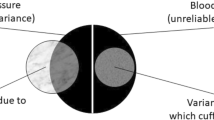Abstract
From the Editors: This is the second column from the Statistics Guru. The Statistics Guru will appear in every issue. In these columns, we briefly discuss appropriate ways to analyze and present data in the journal. As such, the Statistics Guru can be seen both as an editorial amuse bouche and a set of guidelines for reporting data in the International Journal of Behavioral Medicine. If you have ideas for a column, please email the Statistical Editor, Suzanne Segerstrom at segerstrom@uky.edu.
Similar content being viewed by others
References
Dun TJ, Baguley T, Brunsden V. From alpha to omega: a practical solution to the pervasive problem of internal consistency estimation. Br J Psychol. 2014;105:399–412.
Davenport EC, Davison ML, Liou PY, Love QU. Reliability, dimensionality, and internal consistency as defined by Cronbach: distinct albeit related concepts. Educ Meas Issues Pract. 2015;34:4–9.
Sijtsma K. On the use, the misuse, and the very limited usefulness of Cronbach’s alpha. Psychometrika. 2009;74:107–20.
Trapnell PD, Campbell JD. Private self-consciousness and the five-factor model of personality: distinguishing rumination from reflection. J Pers Soc Psychol. 1999;76:284–304.
Martin LL, Tesser A, McIntosh WD. Wanting but not having: the effects of unattained goals on thoughts and feelings. In: Wegner DM, Pennebaker JW, editors. Handbook of mental control. Englewood Cliffs, NJ: Prentice-Hall; 1993. p. 552–72.
Baglin J. Improving your exploratory factor analysis for ordinal data: a demonstration using FACTOR. Pract Assess Res Eval. 2014;19:14. Available online: pareonline.net/getvn.asp?v=19&n=5. Accessed 21 May 2019.
Segerstrom SC, Stanton AL, Alden L, Shortridge BE. A multidimensional structure for repetitive thought: what’s on your mind, and how, and how much? J Pers Soc Psychol. 2003;85:909–21.
Cranford JA, Shrout PE, Iida M, Rafaeli E, Yip T, Bolger N. A procedure for evaluating sensitivity to within-person change: can mood measures in diary studies detect change reliably? Personal Soc Psychol Bull. 2006;32:917–29.
Geldhof GJ, Preacher KJ, Zyphur MJ. Reliability estimation in a multilevel confirmatory factor analysis framework. Psychol Methods. 2014;19:72–91.
Segerstrom SC, Boggero IA, Smith GT, Sephton SE. Variability and reliability of diurnal cortisol in younger and older adults: implications for design decisions. Psychoneuroendocrinol. 2014;49:299–309.
Segerstrom SC, Smith G. Methods, variance, and error in psychoneuroimmunology research: the good, the bad, and the ugly. In: Segerstrom SC, editor. The Oxford handbook of psychoneuroimmunology. New York, NY: Oxford; 2012. p. 421–32.
Wang L, Grimm KJ. Investigating reliabilities of intraindividual variability indicators. Multivar Behav Res. 2012;47:771–802.
Author information
Authors and Affiliations
Corresponding author
Ethics declarations
Conflict of Interest
The author declares that there are no conflicts of interest.
Human and Animal Studies
This article does not contain any studies with human participants or animals performed by the author.
Informed Consent
There was no requirement for informed consent.
Additional information
This is one in a series of statistical guidelines designed to highlight common statistical considerations in behavioral medicine research. The goal is to briefly discuss appropriate ways to analyze and present data in the International Journal of Behavioral Medicine (IJBM). Collectively, the series will culminate in a set of basic statistical guidelines to be adopted by IJBM and integrated into the journal’s official Instructions for Authors, and also to serve as an independent resource. If you have ideas for a future topic, please email the Statistical Editor, Suzanne Segerstrom at segerstrom@uky.edu.
Publisher’s Note
Springer Nature remains neutral with regard to jurisdictional claims in published maps and institutional affiliations.
Rights and permissions
About this article
Cite this article
Segerstrom, S.C. Statistical Guideline #2: Report Appropriate Reliability for your Sample, Measure, and Design. Int.J. Behav. Med. 26, 455–456 (2019). https://doi.org/10.1007/s12529-019-09803-5
Published:
Issue Date:
DOI: https://doi.org/10.1007/s12529-019-09803-5



